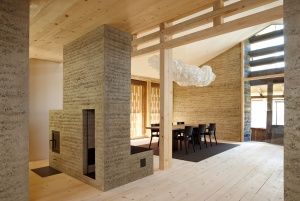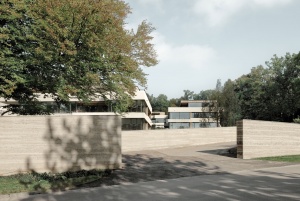Rammed-Earth Walls
Interiors Rammed-earth interior walls have, above all, positive impacts on indoor climate. Their huge mass has a weakening effect on temperature extremes: in a wooden house, for instance, which has to cope without big storage masses, massive rammed-earth walls can offer assured thermal contributions. Besides, heating or cooling supply, according to requirements, can activate their thermal efficiency. Rammed-earth walls reduce both temperature peaks and air moisture content: their capacity to absorb and emit humidity with unusual rapidity, provides a pleasant and healthy indoor climate. Apart from unpleasant odours, earth - in scientific terms referred to as loam - soaks up pollutants often carried in the air, and not least, is often used as a design resource. The horizontal stratification has tranquilizing properties and reveals the material in its unwrought form.
Exteriors Concerning its external use, rammed-earth impresses with its light fastness: after the drying phase, it retains its natural colours, while other materials often fade, darken, change their original tone or gather moss. Drying and moisture-active effects that characterize loam, avoid fungal attacks and development of microorganisms on the long term. Facades resist over decades without colour alterations, while surface luminosity increases perceptibly as time goes by. Rammed-earth used in external walls is not stabilised with additional binding agents and must be continuously protected from humidity and weather conditions. Wall crest and plinth must be developed in such a way as to avoid moisture penetration from the top and the bottom of the wall. In order to ensure erosion prevention, mortar strips are introduced on the exterior edge of the formwork and tamped down every three layers. Stone or brick battens can also be used as effective alternatives, to prevent the excessive washout of the wall through too quick runoff. Minimal erosions must be taken into account both from a structural and an aesthetical point of view, above all on the weather-exposed side: this method, which particularly insists on the naturalness of this material, is also often called calculated erosion. After the first few years, when fine portions of the weather-exposed surface are washed away, the haptic doesn’t suffer sensible alterations anymore. The ecological aspect and the conceptual idea, resulting directly from the earth that constitutes the building, play an ever more important role regarding material decisions.
On-site production system
On site production offers the possibility to employ local material, sometimes even the same excavated soil. Walls are monolithic, and conceived without dilatation joints. During the early drying period, just after formwork stripping, rammed-earth surface lends itself to retouching and creative refinishing. After drying up, pressed relief structures visualise the softness and sensitivity of the once moist loam mass.
Prefab-Production
Prefabrication in earth construction is a reaction to today’s conventional building process, where there’s often no space left for on-site production, as time is short and labour expensive. The evolution and development of prefab-rammed-earth technique improve efficiency on the building site, scheduling becomes exactly calculable, and makes projects more feasible.Such a process enables a weather-independent production, also because the drying process is entirely in the production hall: construction coordination on site is therefore easier and more accurately predictable. This combination allows an optimal fit in the industrialized building processes and has the potential to be optimized and rationalised through modular systems.All elements up to 7000kg and with large thickness can be transported and put in place with a crane, so long as building sites are easily accessible. Despite the industrial prefabrication, a high degree of individuality can be achieved through necessary detail work in the production hall, which allows a flexible and variable execution. Besides, combinations with wooden or concrete frame constructions have proven to be very efficient.Due to the plastic properties of loam, joints between prefab-elements can be smoothly be retouched, making them no longer visible. Precast construction system can therefore also produce large contiguous monolithic-appearing walls. Thanks to close cooperation between project partners it was possible to industrialize high level production and find practical, short-time solutions for large projects.

